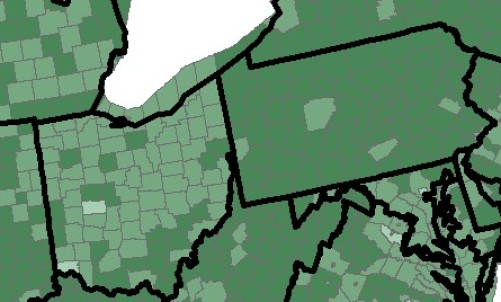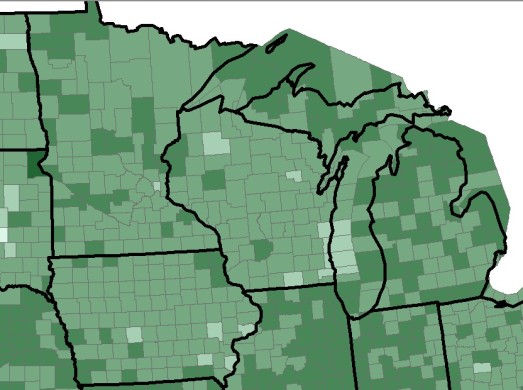Since the early 2000s, a flurry of new voting laws have passed in the states. There is a marked Democrat-Republican divide. Democratic-leaning states, such as California, Oregon, and Massachusetts, have passed laws making access to the ballot easier. Oregon now automatically registers citizens to vote any time they do business with the state. California does the same for those getting driver’s licenses — a must in many parts of a car-crazy state. Massachusetts joins a few other states in allowing pre-registration of 16 year-olds, who then automatically enter the voting rolls upon turning 18: a policy that North Carolina also has, for now, depending on court rulings.
Republican-leaning states, meanwhile, have taken a different turn. Under the auspices of curbing voter fraud, GOP legislators and governors have passed a flurry of new restrictions. Critics, myself included, are quick to point out the dearth of evidence for those voter fraud claims. Yet the theoretical possibility, anecdotes, and research by Richman, et. al. indicating that some fraud may go undetected, all combine to make a case for new laws requiring state-issued Photo ID at the polls, proof of U.S. citizenship to register, limiting early voting, complicating third-party voter registration drives such as those once undertaken by the controversial ACORN, and so forth.
Critics, again myself included, argue that these restrictive new laws are not neutral in their effects. Research by scholars such as Matt Barreto (.pdf) indicate that African-Americans, Latinos, the poor, the disabled, and the elderly are more likely to lack photo ID. Stories, admittedly anecdotal, circulate about voters having trouble getting birth certificates. Some were not born in hospitals and were never issued birth certificates, while others contain clerical errors requiring a Kafkaesque legal labyrinth to untangle. One thing most of these voters seem to share: a tendency to vote for Democrats; that is, they if are able to vote at all. The popularity of these new restrictions in Presidential and Senatorial battleground states like Florida, Ohio, and Wisconsin, heightens worries.
What was the bottom line in 2016? Did the laws put a thumb on the scales and ensure Donald Trump’s victory?
I dove into this question for our roundtable, “Did It Matter in the End? Restrictive Voting Laws and the 2016 Election,” presented at this year’s MPSA conference in Chicago. Using ArcGIS mapping and multivariate regression, I traced the shift in voter turnout in each county in the U.S. I also considered the impact of various independent variables, such as percentage of white residents in a county, economic growth or decline, population (an urban-rural measure, since rural counties have smaller populations), and other factors as controls to explain vote changes between 2012 and 2016. In addition, I put in the new voting laws. After controlling for the “usual suspects” which explain partisan shifts and turnout change, is there anything left for these new voting laws to explain? In other words, did they have an impact?
In terms of turnout, the evidence does suggest that restrictive new laws may have had an impact, at least in certain regions. The most dramatic contrast is between Ohio and Pennsylvania, two states that “flipped” from Democrat to Republican in 2016. Ohio shows marked turnout decline relative to the Keystone State. However, there is no clear partisan impact resulting from this.

In the map above: darker green=higher turnout relative to 2012, lighter = lower turnout
To the north and west of these states lies a region containing three states which flipped from Obama to Trump (Iowa, Michigan, and Wisconsin) and one where Trump made major gains but did not win (Minnesota). In the northern Midwest, only Wisconsin had new, restrictive voting laws take effect between 2012 and 2016. Sure enough, turnout dropped in diverse, urban, Democratic-voting Milwaukee County, by 0.3%. Problem is, it also shifted in other area urban counties. In fact, the 3% drop in Hennepin County (Minneapolis), and 2% drop in Polk County (Des Moines) were both greater than that in Milwaukee—and Minnesota and Iowa had no new voter ID laws. Wayne County (Detroit) and Cook County (Chicago), also in states with no new restrictive voting laws, had smaller drops at 0.2% and 0.01%, respectively. Again, it is important to note that I am computing turnout as a percentage of the country’s adult population, as per U.S. Census population estimates from the year before the election. Furthermore, the turnout drop in Milwaukee did not come with a Republican shift—if anything Milwaukee shifted to being more Democratic—more so than Detroit or Minneapolis.


In the map above, red=Republican shift, blue = shift away from Republican. Milwaukee is the southernmost blue county on Lake Michigan, in eastern Wisconsin
In other words, the results did not fit the prediction that restrictive new laws would hinder Democratic vote share.
The results were even more startling with my regression analysis. Regarding turnout, the imposition of other new restrictions (limiting early voting days, reigning in organized voter registration drives, etc.) correlates with higher voter turnout — evidence of a possible “backlash” effect. Democrats in affected states may use the presence of these laws to mobilize constituencies that feel targeted by the laws, a sort of “don’t let them take your vote away” message, which colleagues and I found may have boosted Democratic turnout for Pennsylvania in 2012, when that state did try to implement new voter restrictions. It probably didn’t help that a Republican leader in the state legislature boasted that the law would deliver Pennsylvania to Mitt Romney.
Even more startling was my regression for Republican vote share. Even when controlling for other factors (% white, job loss, urban-rural, etc.), there is a strong, negative relationship between the imposition of these new laws and Republican vote share.
That’s right: it appears that restrictive new voting laws hurt voter turnout for Trump.
How can this be? A thoughtful, post-election analysis by two reporters at the Atlanta Journal-Constitution suggests an answer. Journalists Kristina Torres and Jennifer Peebles secured the entire voter file for Georgia and analyzed it for patterns. Their findings: counties that showed strong increases in support for Trump, mostly rural, also showed significant increases in ballots cast by new and infrequent voters in 2016. Meanwhile, some of the voters from 2012 did not vote this time. The result was an older, whiter, more-rural electorate.
New voting laws are likely to have the greatest impact on new and infrequent voters. Those who vote regularly will adjust to a photo ID or proof-of-citizenship requirement, while those that do not may not be prepared for the changes. Given that Trump appears to have mobilized new and infrequent voters, it makes sense that those voters would be the most “thrown” by new requirements.
Thus the impact of new restrictions appears to be greatest on those who are new to voting–one of Democrats’ biggest fears, but with a twist, in that it was the Republican, not the Democratic candidate, that mobilized such voters in 2016. This is not to say that the laws won’t hurt Democrats next time, as they are the party that typically tries to bring in new voters through registration drives, election-day canvassing, “souls to the polls” drives for Sunday early voting at predominantly African-American churches, and so forth. Yet it appears to be Trump that took the brunt this time – and it did not prevent his Electoral College victory.
Finally, a personal note: I dislike these laws. I find scant evidence for the voter fraud claims used to substantiate them, and I see little rationale (.pdf) for them other than for the purpose of hindering those who do have a right to vote, from exercising that right. I also think these laws, passed with few exceptions by Republican state legislatures, clearly are meant to target Democrat-leaning voters. At the same time, I am a political scientist, and facts are facts. The fact that these laws appear to have hindered vote shifts to a (quirky, unexpected) Republican candidate this year does not mean they will do the same in the future. More importantly, it does not justify the laws. The voter-fraud premise remains as flimsy as before, while evidence of disparate impact on society’s most vulnerable remains credible.
The suggestion that the laws hinder Democratic vote share has always been an understood supposition in the debate over them, but it is not part of the actual, legal case against them. Most importantly, as political scientists we must go where the data take us. These laws do appear to be affecting elections – just not in the direction predicted… at least, not this time.
About the author: Michael A. Smith is a Professor of Political Science at Emporia State University where he teaches classes on state and local politics, campaigns and elections, political philosophy, legislative politics, and nonprofit management. Read more on the MPSA blog from Smith and follow him on Twitter.
